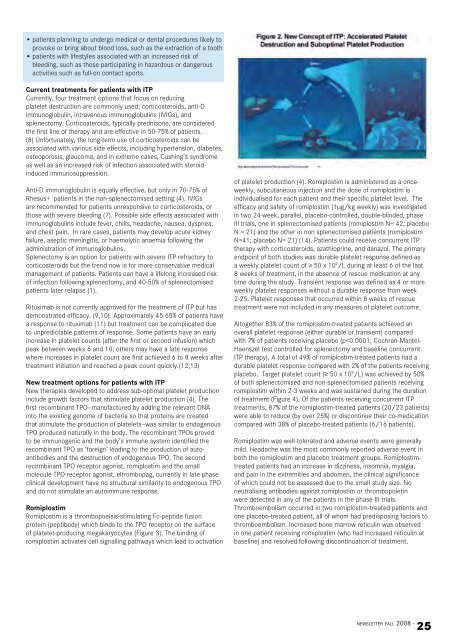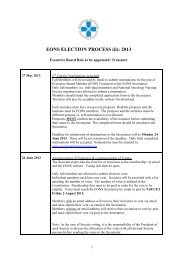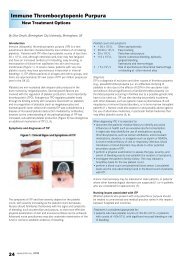English - the European Oncology Nursing Society
English - the European Oncology Nursing Society
English - the European Oncology Nursing Society
- No tags were found...
Create successful ePaper yourself
Turn your PDF publications into a flip-book with our unique Google optimized e-Paper software.
• patients planning to undergo medical or dental procedures likely toprovoke or bring about blood loss, such as <strong>the</strong> extraction of a tooth• patients with lifestyles associated with an increased risk ofbleeding, such as those participating in hazardous or dangerousactivities such as full-on contact sports.Current treatments for patients with ITPCurrently, four treatment options that focus on reducingplatelet destruction are commonly used: corticosteroids, anti-Dimmunoglobulin, intravenous immunoglobulins (IVIGs), andsplenectomy. Corticosteroids, typically prednisone, are considered<strong>the</strong> first line of <strong>the</strong>rapy and are effective in 50-75% of patients.(8) Unfortunately, <strong>the</strong> long-term use of corticosteroids can beassociated with various side effects, including hypertension, diabetes,osteoporosis, glaucoma, and in extreme cases, Cushing’s syndromeas well as an increased risk of infection associated with steroidinducedimmunosuppression.Anti-D immunoglobulin is equally effective, but only in 70-75% ofRhesus+ patients in <strong>the</strong> non-splenectomised setting (4). IVIGsare recommended for patients unresponsive to corticosteroids, orthose with severe bleeding (7). Possible side effects associated withimmunoglobulins include fever, chills, headache, nausea, dyspnea,and chest pain. In rare cases, patients may develop acute kidneyfailure, aseptic meningitis, or haemolytic anaemia following <strong>the</strong>administration of immunoglobulins.Splenectomy is an option for patients with severe ITP refractory tocorticosteroids but <strong>the</strong> trend now is for more conservative medicalmanagement of patients. Patients can have a lifelong increased riskof infection following splenectomy, and 40-50% of splenectomisedpatients later relapse (1).Rituximab is not currently approved for <strong>the</strong> treatment of ITP but hasdemonstrated efficacy. (9,10). Approximately 45-65% of patients havea response to rituximab (11) but treatment can be complicated dueto unpredictable patterns of response. Some patients have an earlyincrease in platelet counts (after <strong>the</strong> first or second infusion) whichpeak between weeks 6 and 10; o<strong>the</strong>rs may have a late responsewhere increases in platelet count are first achieved 6 to 8 weeks aftertreatment initiation and reached a peak count quickly.(12,13)New treatment options for patients with ITPNew <strong>the</strong>rapies developed to address sub-optimal platelet productioninclude growth factors that stimulate platelet production (4). Thefirst recombinant TPO—manufactured by adding <strong>the</strong> relevant DNAinto <strong>the</strong> existing genome of bacteria so that proteins are createdthat stimulate <strong>the</strong> production of platelets—was similar to endogenousTPO produced naturally in <strong>the</strong> body. The recombinant TPOs provedto be immunogenic and <strong>the</strong> body’s immune system identified <strong>the</strong>recombinant TPO as ‘foreign’ leading to <strong>the</strong> production of autoantibodiesand <strong>the</strong> destruction of endogenous TPO. The secondrecombinant TPO receptor agonist, romiplostim and <strong>the</strong> smallmolecule TPO receptor agonist, eltrombopag, currently in late phaseclinical development have no structural similarity to endogenous TPOand do not stimulate an autoimmune response.RomiplostimRomiplostim is a thrombopoeisis-stimulating Fc-peptide fusionprotein (peptibody) which binds to <strong>the</strong> TPO receptor on <strong>the</strong> surfaceof platelet-producing megakaryocytes (Figure 3). The binding ofromiplostim activates cell signalling pathways which lead to activationof platelet production (4). Romiplostim is administered as a onceweekly,subcutaneous injection and <strong>the</strong> dose of romiplostim isindividualised for each patient and <strong>the</strong>ir specific platelet level. Theefficacy and safety of romiplostim (1μg/kg weekly) was investigatedin two 24-week, parallel, placebo-controlled, double-blinded, phaseIII trials, one in splenectomised patients (romiplostim N= 42; placeboN = 21) and <strong>the</strong> o<strong>the</strong>r in non splenectomised patients (romiplostimN=41; placebo N= 21) (14). Patients could receive concurrent ITP<strong>the</strong>rapy with corticosteroids, azathioprine, and danazol. The primaryendpoint of both studies was durable platelet response defined asa weekly platelet count of ≥ 50 x 10 9 /L during at least 6 of <strong>the</strong> last8 weeks of treatment, in <strong>the</strong> absence of rescue medication at anytime during <strong>the</strong> study. Transient response was defined as 4 or moreweekly platelet responses without a durable response from week2-25. Platelet responses that occurred within 8 weeks of rescuetreatment were not included in any measures of platelet outcome.Altoge<strong>the</strong>r 83% of <strong>the</strong> romiplostim-treated patients achieved anoverall platelet response (ei<strong>the</strong>r durable or transient) comparedwith 7% of patients receiving placebo (p
















